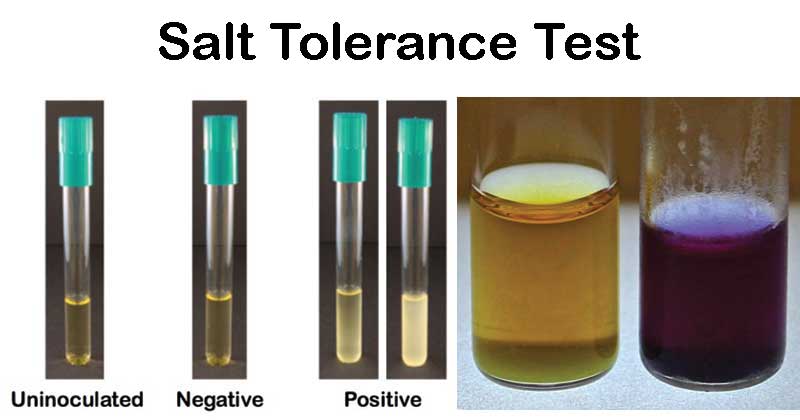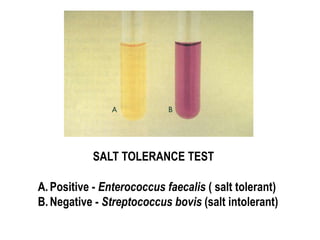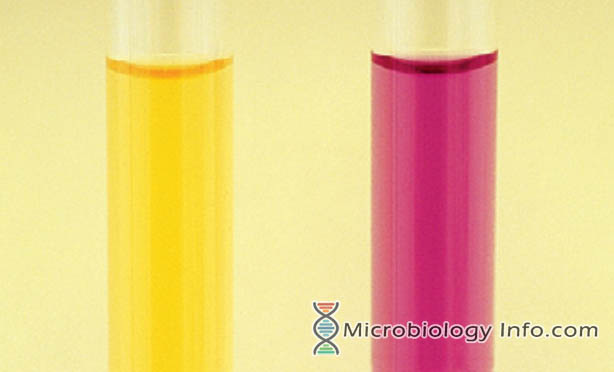18.which of the Following Grows in 6.5 Nacl
Occasionally ß-hemolytic strains of E. Are salt-tolerant and will grow in the presence of 65 NaCl while nonenterococcal group D streptococci will not.

Salt Tolerance Test Principle Procedure Results Limitations
Brain Heart Infusion BHI Agar w 65 NaCl can be used to differentiate Enterococcusspp.

. It is a selective medium which tests the ability of an organism to survive in a salt-rich environment. This medium allows determination of which category an unknown bacterium falls into. Enterococcus faecalis You have isolated small white beta-hemolytic colonies on blood agar.
An inoculum from a pure culture is transferred aseptically to a sterile tube of 65 NaCl broth The inoculated tube is incubated at 35-37 C for 24 hours. 1 Streptococcus agalactae 2 Enterococcus fecalis 3 Streptococcus bovis 4 Streptococcus pneumoneae 5 NULL. A gray nonhemolytic catalase-negative colony grows on a CNA plate.
Sodium chloride 65 inhibits the growth of salt-intolerant bacteria by interfering with membrane permeability and osmotic equilibrium. The 65 NaCl broth is selective only which means that you will read it by determining whether or not an organism grew. Enterococci are bile esculin-positive hippurate- negative and have the ability to grow in 65 NaCl.
Observe the medium for the appearance of colonies in the plate. Most organisms cannot survive in such an environment. How is the test performed.
The color of the medium is inconsequential to the positive result. From nonenterococcal group D streptococci5Enterococcusspp. The salt tolerance test is performed using Tryptic Soy Broth with added sodium chloride regular table salt to create an overall salt concentration of 65.
Will grow in the presence of 65 NaCl while other streptococci including group D streptococci not enterococci and some group B streptococci will not. Enterococcus spp Resistant to vancomycin. Some strains of E.
A gamma-hemolytic Streptococcus that blackens bile esculin agar but does not grow in 65 NaCl broth is most likely. Most strains are α or non-hemolytic. Growth of some bacteria is inhibited by sodium chloride NaCl commonly known as table salt.
Group D Streptococcus d. Growth in broth containing 65 NaCl is determined in heart infusion broth base with the addition of 6 more NaCl. Bergeys manual of bacteriology classified Streptococci based on growth at 65 NaCl 10 and 45 degree centigrade.
To make the test easier to read we add 05 dextrose and brom cresol purple indicator. Enterococci will grow in the presence of 65 NaCl and utilize dextrose in the medium. However of these two only Enterococcus grows in the presence of 65 NaCl 99 Gram stain examination from a blood culture bottle show dark blue spherical organisms in.
The salt used in both the MSA plates and the 65 NaCl broth is sodium chloride or regular table salt. They grow well in sodium azide SFStreptococcus faecalis broth 40 bile 65 sodium chloride and 01 methylene blue and can survive at 56C for 30 minutes or at a pH of 96. A positive test is indicated by the presence of turbidity.
Heart infusion base contains 05 NaCl. 364 Enterococci are responsible for 5 to 18 of the cases of IE and the incidence seems to be increasing. If a microbe is sensitive to NaCl it will be unable to grow in 65 NaCl broth.
It is also. Group B streptococcus b. For several years at the clinical microbiology laboratory of the Faculté de Médecine Vétérinaire FMV Université de Montréal identification of streptococci and other.
Nearly all strains produce LAP grow in 65 NaCl and grow at 10ΕC and 45ΕC. 65 NaCl broth is Tryptic Soy Broth with additional NaCl added to raise the. After 24 hours incubation there.
In some instances the growth of the bacterium will have altered the color of the agar culture medium. If an organism is a gram positive cocci non-hemolytic catalase negative bile esculin positive and 65 NaCl positive which is most likely the organism. Some species are motile.
These tests include the CAMP test esculin hydrolysis ESC sodium hippurate hydrolysis HIP acid production from inulin INU and trehalose growth in a broth containing 65 NaCl and Lancefield grouping. The organism grows in 65 NaCl broth and the reaction on 6 µgmL of vancomycin in Mueller Hinton agar is shown in the bottom image. Inoculum A fresh inoculum grow in Todd Hewitt broth is preferred.
The organism should be reported as. Growth in 65 NaCL Temperature Group 45 C 10 C - - - Strep. Enterococci are relatively resistant to penicillin and require combination therapy to treat serious infections A beta-hemolytic catalse-positive gram-positive coccus is coagulase negative by the slide coagulase test.
Raffinosus do not grow at 10ΕC or produce LAP but this is not consistent or predictable. How is growth in 65 NaCl determined. Strikingly the maximum growth rate of NaCl single crystal 65 15 lms found to have been noticed only for the cubical seed and after reaching a super saturation of S 145 the growth rate.
Streptococci other than Enterococcus spp. Group D Streptococcus c Group D streptococci and Enterococcus produce a positive bile esculin test. There will be no color change.
3 for both analysed materials. It is a nutrient broth containing 65 sodium chloride or table salt. The acid produced by the metabolism of dextrose causes the indicator brom cresol purple to change from purple to yellow.
Definitive Definitive identification may require additional biochemical andor serological testing. The medium used is 65 NaCl broth. The depression of water freezing temperature with the growing NaCl concentration in the solution can be observed Fig.
The following biochemical results are obtained-65 NaCl. For the highest analysed concentration almost half of the volume of pores for silica gel 113 nm and more than 90 pore volume for SBA-15 65 nm remain unfrozen below -40 C. Negative The most likely identification is.
The culture producing colonies on the streak lines is capable of growing in the presence of 75 NaCl. 7 365 366 367 The disease usually runs a subacute course and affects older men. Others are capable of growing in its presence.
Eg Group A and Group B streptococci may grow in BHI Broth w 65 NaCl.

Salt Tolerance Test Principle Procedure Uses And Interpretation

Biochemical Tests For Identification Of Bacteria

Bile Solubility Test Principle Procedure Results Microbe Online
Comments
Post a Comment